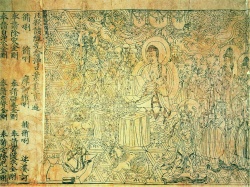Difference between revisions of "Five Āgamas"
Jump to navigation
Jump to search
| (One intermediate revision by the same user not shown) | |||
| Line 1: | Line 1: | ||
[[File:03 diamond sutra.jpg|thumb|250px|]] | [[File:03 diamond sutra.jpg|thumb|250px|]] | ||
| + | |||
| + | |||
| + | |||
| + | |||
| + | |||
| + | |||
| + | |||
| + | |||
<poem> | <poem> | ||
[[Five Āgamas]] ([[五阿含]]). An [[Āgama]] is a collection of early [[Buddhist scriptures]]. | [[Five Āgamas]] ([[五阿含]]). An [[Āgama]] is a collection of early [[Buddhist scriptures]]. | ||
| Line 6: | Line 14: | ||
the [[Madhyama Āgama]] ([[middle-length discourses]]), | the [[Madhyama Āgama]] ([[middle-length discourses]]), | ||
the [[Saṁyukta Āgama]] ([[connected discourses]]), | the [[Saṁyukta Āgama]] ([[connected discourses]]), | ||
| − | the [[Ekottarika Āgama]] (discourses ordered by the number of [[Dharmas]] in each {{Wiki|discourse}}), and | + | the [[Ekottarika Āgama]] ([[discourses]] ordered by the number of [[Dharmas]] in each {{Wiki|discourse}}), and |
the [[Kṣudraka Āgama]] ([[minor discourses]]). | the [[Kṣudraka Āgama]] ([[minor discourses]]). | ||
| − | They are parallel but not identical to the Five [[Nikāyas]] in the [[Pāli Canon]], which are the | + | |
| + | They are parallel but not [[identical]] to the Five [[Nikāyas]] in the [[Pāli Canon]], which are the | ||
[[Dīgha Nikāya]], | [[Dīgha Nikāya]], | ||
the [[Majjhima Nikāya]], | the [[Majjhima Nikāya]], | ||
| Line 15: | Line 24: | ||
the [[Aṅguttara Nikāya]], | the [[Aṅguttara Nikāya]], | ||
and the [[Khuddaka Nikāya]]. | and the [[Khuddaka Nikāya]]. | ||
| + | |||
| + | |||
| + | |||
</poem> | </poem> | ||
{{R}} | {{R}} | ||
Latest revision as of 14:34, 1 February 2024
Five Āgamas (五阿含). An Āgama is a collection of early Buddhist scriptures.
the Five Āgamas in the Chinese Canon are
the Dīrgha Āgama (long discourses),
the Madhyama Āgama (middle-length discourses),
the Saṁyukta Āgama (connected discourses),
the Ekottarika Āgama (discourses ordered by the number of Dharmas in each discourse), and
the Kṣudraka Āgama (minor discourses).
They are parallel but not identical to the Five Nikāyas in the Pāli Canon, which are the
Dīgha Nikāya,
the Majjhima Nikāya,
the Saṁyutta Nikāya,
the Aṅguttara Nikāya,
and the Khuddaka Nikāya.
